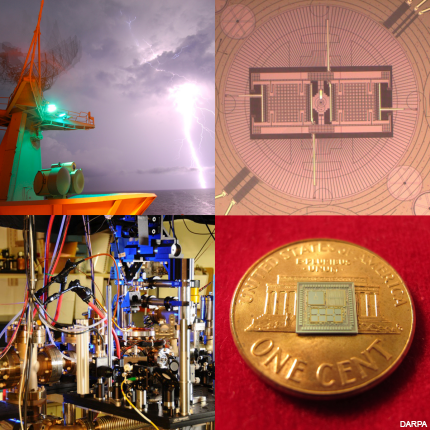DOD puts emphasis on Navigation Warfare, accurate GPS signals
A new instruction directs all military branches and components to incorporate Navwar and ensure that Positioning, Navigation, and Timing tools are reliable.

DARPA’s next generation of PNT technologies could include miniaturized sensors, pulsed lasers, quantum physics and lightning strikes.
The Global Positioning System has long been a great tool for military—and, of course, civilian—activities, but the military’s heavy reliance on it also makes it a likely target. Which is the rationale behind a Defense Department instruction issued Feb. 5 that both mandates the use of what’s called Navigation Warfare, or Navwar, and provides guidelines for the Positioning, Navigation, and Timing (PNT) tools used in Navwar—including the possibility of technologies other than GPS.
For starters, the instruction from DOD Acting CIO Terry Halvorsen directs all of the military services and other DOD components to employ Navwar, in a move that emphasizes the ever-growing importance of the electromagnetic spectrum. The Pentagon last year updated its electronic warfare policy, calling for EW to be incorporated into the full range of military capabilities, including navigation warfare.
While EW covers the full range of the spectrum, navigation warfare involves taking steps to ensure the accuracy of GPS signals, for example when conducting a precise strike against a terrorist cell while trying to avoid any civilian casualties. In that scenario, offered by Defense Media Network, U.S commanders would check with the Air Force Space Command to find out when the best arrangement of four to six GPS satellites are over the area, so the satellites can deliver the most accurate location information. Although people generally know GPS to be accurate, the kind of precision needed for this type of operation can vary, depending on where the satellites are and even on which individual satellites are involved.
Forces also have to be prepared for attempts to jam their signals, perhaps with tools such as programs like GPS Jammer Location (JLOC) software that, in this scenario, can identify the model of the jammer being used by the terrorist, enabling U.S. forces to overcome it.
The services have already been using Navwar, of course, but the new instruction underscores its growing importance. Likewise with PNT tools. Basically, the instructions says to avoid tools that haven’t been approved by DOD, but also goes on to caution against relying on a single source of PNT information, something researchers have been working on.
The Defense Advanced Research Projects Agency is has several PNT-related projects under way, intended to improve accuracy, allow fast integration of PNT sesnors across multiple platforms, and even go beyond GPS. The agency has several programs underway to develop PNT capabilities that don’t use the satellite system, but instead use arrays of sensors and new types of signal processing that can function in difficult environments, ad hoc networks of separate nodes, and new architectures that would allow integrate other domains such as communications, electronic warfare or ISR systems into PNT.
Some of the tools under development include miniaturized sensors, pulsed lasers and quantum physics. Researchers are even considering incorporating lightning strikes into PNT. Several other projects are working on ways to make extremely precise and portable atomic clocks that would enable improvements in positioning signals, radars and lasers, which in turn would improve PNT systems.
Defense contractors also have been working on the problem, with Boeing saying late last year that it had developed a new anti-jamming technology that uses a secure tactical waveform that the company said is shielded from interference.




